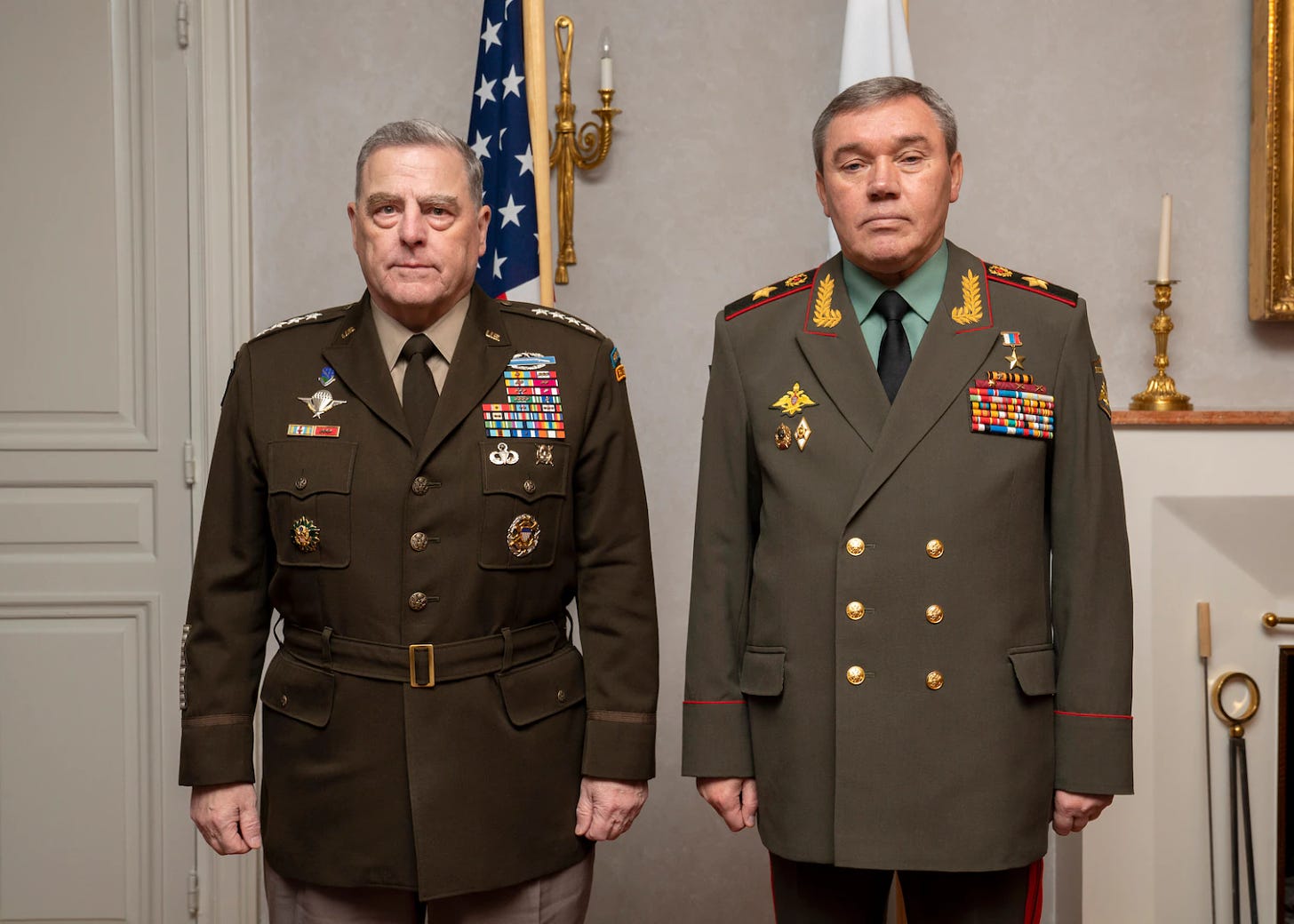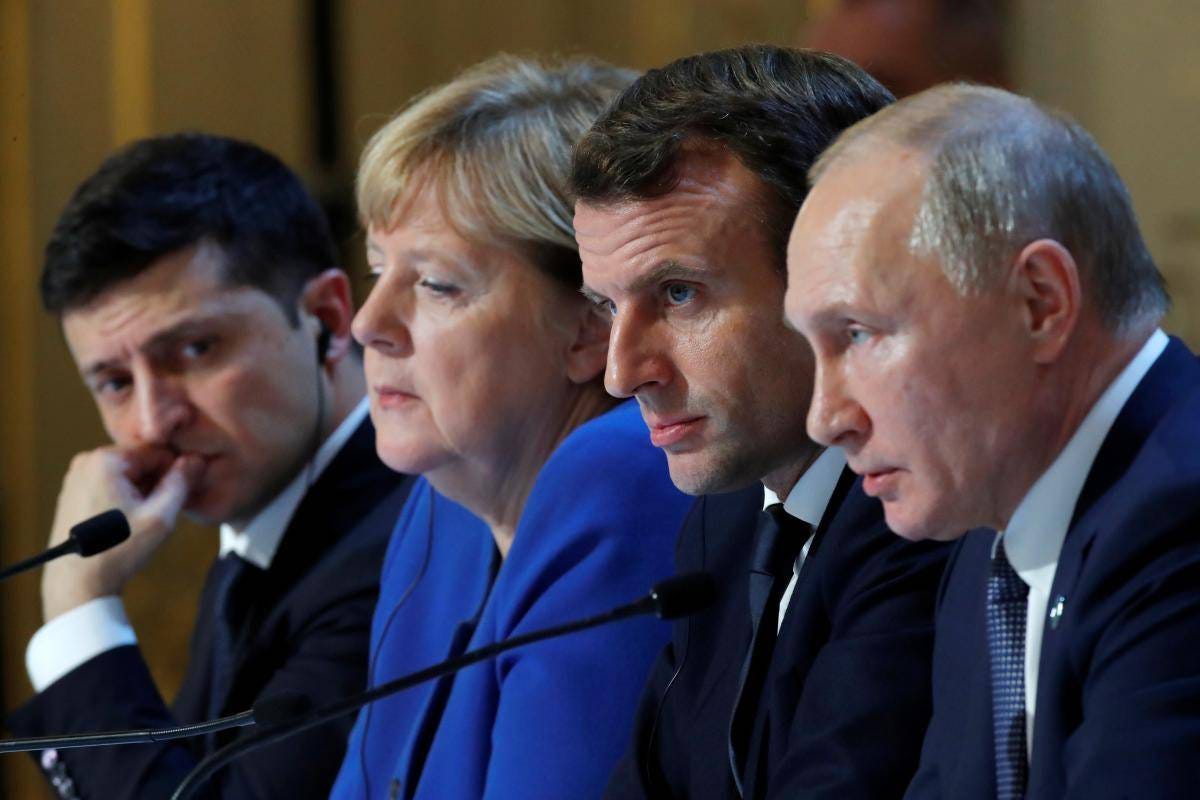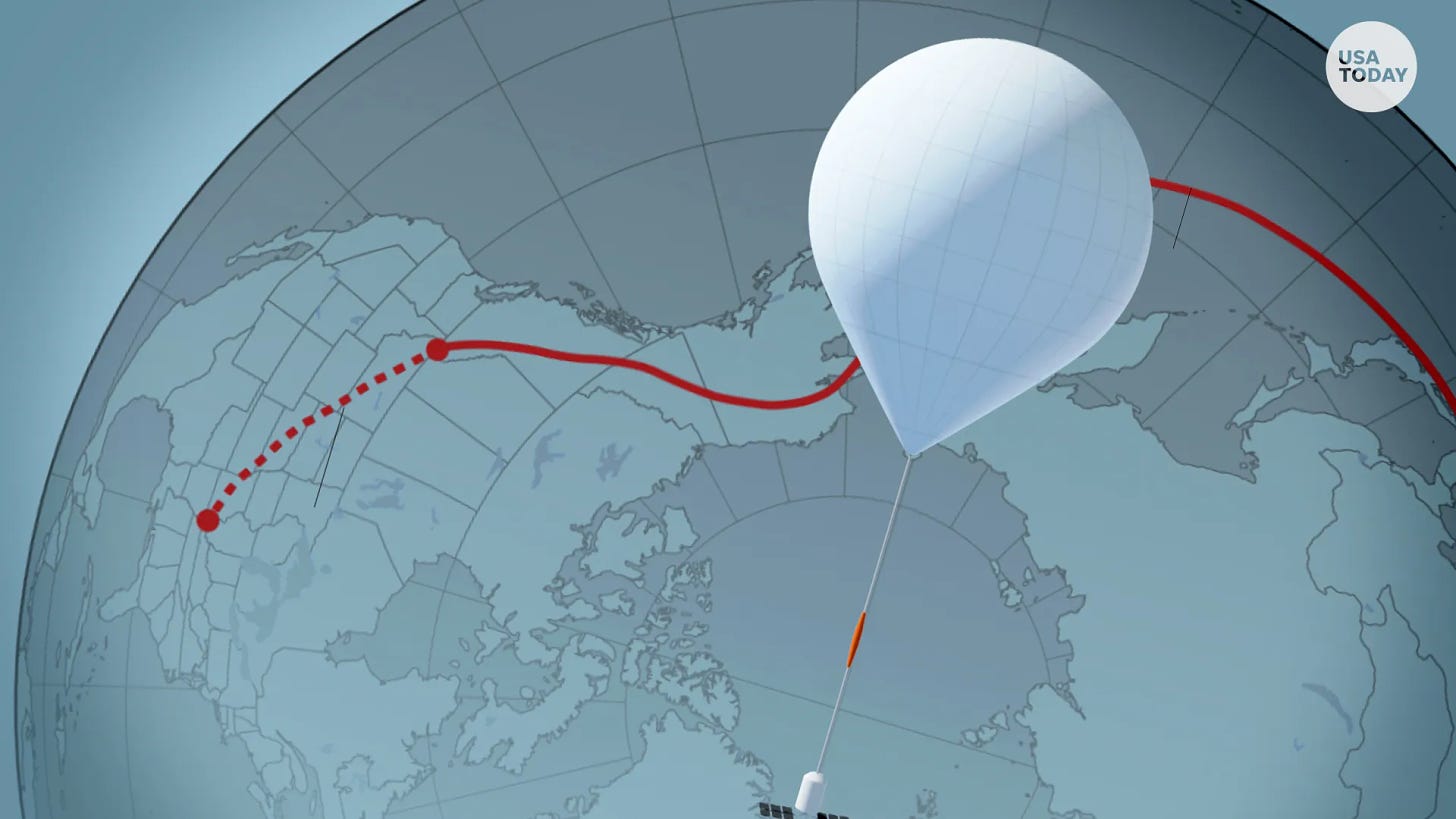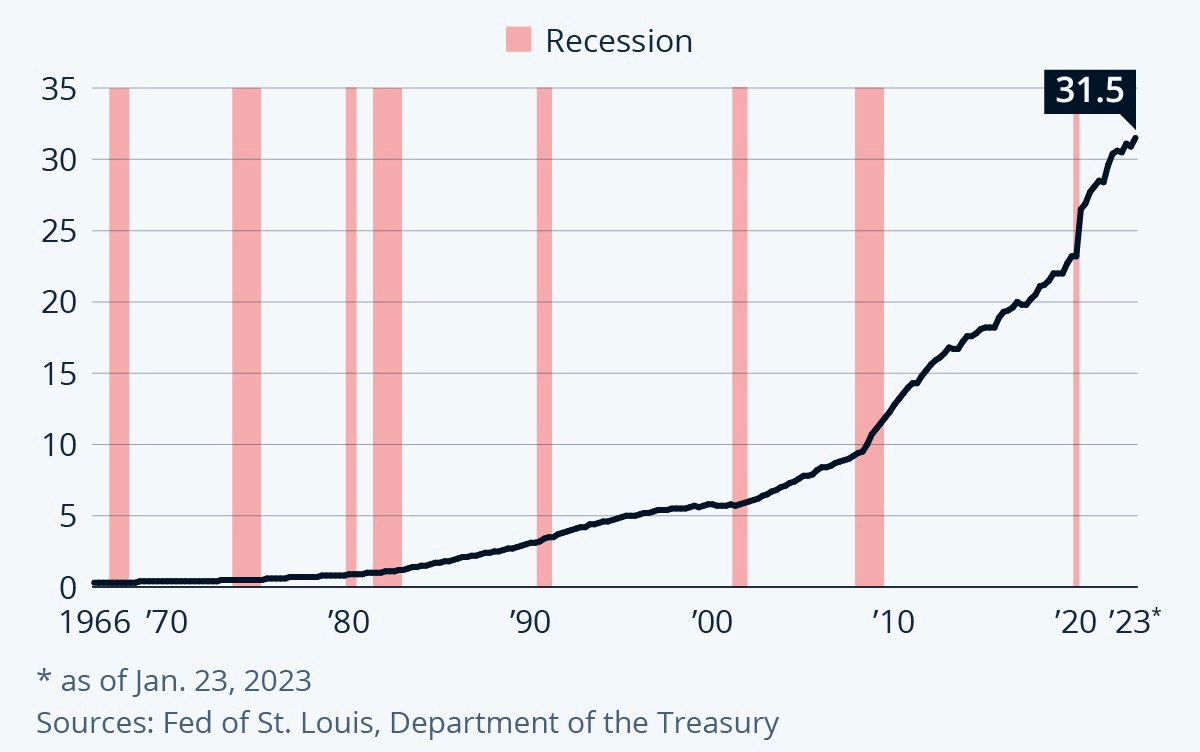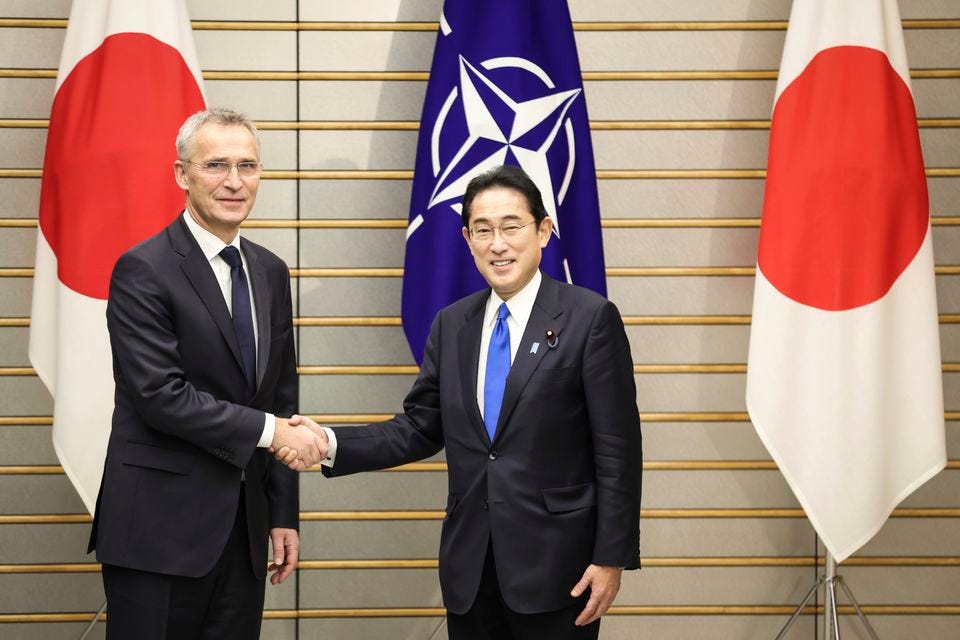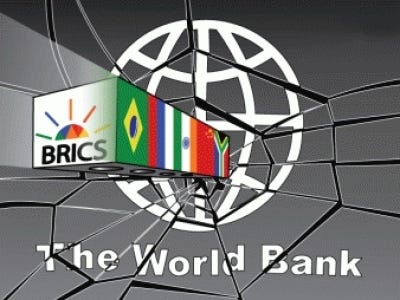Munich Moment
As politicians & diplomats fly into Munich media packs balloon. Minsk II at UNSC. Blinken seeks to meet Wang Yi and Biden wants to chat with Xi Jinping. Ukraine not balloons are negotiation topics
UPDATE: Up up and away to Munich. After the furore over a big balloon the far more serious topic of US proxy Ukraine’s reversals in Bakhmut and elsewhere are the key topics for discussion. The past week has seen China, India, ASEAN, Africa, Latin America and Middle East join in the calls for a truce and negotiated settlement. European leaders are watching their economies weaken and surely seek to ease tensions too. The fragile “traffic-light” coalition in Germany is falling apart and China has met with France and Hungary before Munich and Biden is heading to Poland. Can President Biden be a “peacemaker” or are we set for increasing escalation and another drawn out loss for the US. Stoltenberg’s imminent departure and the Nordstream revelations signal that more than balloons are in the Munich air.
Blinken eyes balloon détente in possible China meeting
U.S. officials are sending multiple messages via media reports that they seek a high-level meeting between Secretary of State Antony Blinken and China's top diplomat Wang Yi in Munich this week. The State Department on Wednesday formally announced Blinken's plan to attend the Munich Security Conference, giving him an opportunity to re-establish high-level communications in the wake of the balloon fiasco.
However, China and Wang Yi have not officially confirmed and are certainly trying to ascertain what the US will bring to the table after it imposed greater sanctions on technology - semiconductors, balloon manufacturers and Huawei. US sources have begun to downplay the incident leaking reports that the Chinese explanation was in fact true and President Biden has said that other balloons were not Chinese. Biden also said he sought a meeting with President Xi Jinping before he heads to Poland for a major speech on Ukraine.
The annual Munich Security Conference is the first opportunity since the Bali G20 for high-level meetings and the Ukraine will top the list. China and many other representatives from ASEAN, Latin America, Africa, Middle East and Europe will be seeking assurances that the US is actively seeking a truce in Ukraine and a negotiated settlement. This is in light of the dire economic conditions in Germany, Japan and the US and Russia’s strong gains over the previous month. Ukraine can no longer be supplied with sufficient munitions or armaments and it is losing soldiers at an alarming rate. Jens Stotenberg is being replaced and Zelensky has dismissed his defense minister and hundreds of other senior and mid level officials. Meanwhile German chancellor Olaf Scholz is furious with “traffic-light” coalition partner and foreign minister Annalena Baerbock for acting with the US and UK behind his back to pressure Germany to provide tanks and not disclosing that she knew about the US sabotage of Nordstream pipelines.
Vice President Kamala Harris, will be in attendance and deliver a speech. Harris told Politico that she does not believe the balloon debacle should affect relations: "We seek competition but not conflict or confrontation." The US administrations gradual retraction of ballon hyperbole is a choreographed diplomatic move to improve the Biden administration's relations with Beijing as it increases both security and economic pressure on both Russia and China.
Treasury Secretary Janet Yellen was scheduled to travel to China for important conversations on the state of the global economy to follow up on her disappointing meeting with Liu He in Zurich last month. Beijing has declined a request from US Defense Secretary Lloyd Austin in the wake of the balloon farce. Whitehouse spokesperson Ned price has said only that “we are open and we are committed to keeping lines of communication open.”
Read more here.
The Editor
General Milley: Russia-Ukraine war will end with negotiations
Despite neither Ukraine nor Russia showing signs of wanting to negotiage, US General Mark Milley told the Financial Times on Feb. 16. that it is likely the war will end at the negotiating table.
"It will be almost impossible for the Russians to achieve their political objectives by military means. It is unlikely that Russia is going to overrun Ukraine. It's just not going to happen," said Milley, adding that it will be "very, very difficult" for Ukraine to expel all Russian forces from occupied territory.
"It's not to say that it can't happen…" he said. "But it's extraordinarily difficult. And it would require essentially the collapse of the Russian military,"
This is not the first time that Milley has said the war will end with negotiations. In November 2022, he raised the ire of Ukrainian officials when he said that the Ukrainians should use Russian losses to their advantage to negotiate a peace settlement.
He later clarified his statements, adding that it was “up to Ukraine to decide how or when or if they will negotiate with the Russians."
Read more here.
UN Security Council to discuss broken Minsk II Agreements
On 17 February, the Security Council will convene for an open briefing on Ukraine under the “Threats to international peace and security” agenda item. Russia requested the meeting to mark the eighth anniversary of the “Package of Measures for the Implementation of the Minsk Agreements”, also known as the Minsk II agreement, adopted on 12 February 2015.
Since 2019, Russia has organised a meeting annually on the occasion of the anniversary of the Minsk II agreement. This year’s meeting will take place in the altered context of Russia’s invasion of Ukraine on 24 February 2022. The last annual Council meeting on the Minsk II agreement took place on 17 February 2022, a week before Russia started its military incursion. Council members’ sharply opposing views on the implementation of the Minsk II agreement and whether it has played a role in fuelling large-scale conflict in Ukraine are likely to colour the discussions at tomorrow’s briefing.
This year’s proceedings at the General Assembly around the anniversary of the Minsk II agreement will depart from past practice. In previous years, the Council meeting on the Minsk II agreement has preceded the annual General Assembly debate on the agenda item “The situation in the temporarily occupied territories of Ukraine”, typically scheduled for 23 February. This year, however, Ukraine has requested the resumption of the 11th Emergency Special Session (ESS) on 22 February, during which UN member states will vote on a draft resolution underlining the principles of a comprehensive, just, and lasting peace in Ukraine. The draft text underscores the need to reach, as soon as possible, a peaceful settlement consistent with the UN Charter, including the principles of sovereign equality and territorial integrity. In this regard, the text reiterates the General Assembly’s demand that Russia withdraw all its forces from Ukraine.
In an interview with the German newspaper Die Zeit, former German chancellor Angela Merkel revealed the West's real intention behind its negotiation with Russia and Ukraine to promote a ceasefire in 2014. She admitted the Minsk agreements were an "attempt to give Ukraine time" and that Kiev had used it "to become stronger."
Background
The Minsk agreements—Minsk I (signed on 5 September 2014) and Minsk II—outlined steps for ending the conflict in eastern Ukraine through a political settlement. The conflict, which erupted shortly after Russia annexed Crimea in 2014, involved fighting between the Ukrainian government and pro-Russian separatists in the two regions of Donetsk and Luhansk in the Donbas region of eastern Ukraine. The Minsk II agreement—signed by Russia, Ukraine, the OSCE, and former separatist leaders Alexander Zakharchenko and Igor Plotnitski—was endorsed by the Security Council in resolution 2202 of 17 February 2015. It stipulated a ceasefire in certain areas of the Donetsk and Luhansk regions and the withdrawal of military equipment by both sides. The agreement included a commitment by Kyiv to organise local elections and grant special status to the separatist-held areas in eastern Ukraine. It also called for the withdrawal of “all foreign armed formations, military equipment, as well as mercenaries” from Ukraine and the reinstatement of Ukraine’s full control over its border.
The agreement failed to achieve tangible progress. From the outset of the conflict until Russia’s invasion of Ukraine in 2022, fighting claimed the lives of more than 14,000 people, including approximately 3,000 civilians, and injured more than 7,000 civilians, according to the Office of the UN High Commissioner for Human Rights (OHCHR).
Russia and Ukraine have held divergent interpretations of the Minsk II agreement, particularly regarding the sequencing of steps for its implementation. Moscow insisted that Kyiv must first implement the political commitments and enact constitutional amendments recognising the special status of Donetsk and Luhansk. Kyiv maintained that security measures took precedence, and that a ceasefire had to be established with Ukraine regaining control of its territory.
Moscow’s decision to recognise the independence of the two separatist regions in eastern Ukraine on 21 February 2022 was seen by many countries as a violation of Russia’s commitments under the Minsk II agreement. At a 21 February 2022 Council briefing on Ukraine, for example, the US argued that Russian President Vladimir Putin had effectively “torn the Minsk agreements to shreds”. In contrast, Russia has claimed that the Minsk II agreement was a ploy by Ukraine and its allies to buy time to rearm Ukraine for an eventual confrontation with Russia. It has blamed Western countries for encouraging Kyiv to flout the Minsk agreements, justifying its invasion as a reaction to Ukraine’s failure to engage in dialogue with the breakaway regions in eastern Ukraine.
Tomorrow’s Meeting
Tomorrow’s briefing will take place against the backdrop of a renewed Russian military offensive in the eastern Donbas region. Russia has also continued to launch air and missile assaults targeting civilian infrastructure across Ukraine, carrying out six large-scale missile campaigns against energy facilities this year. The attacks have triggered massive blackouts and a reduction in water supplies throughout the country.
Jenča is expected to provide an overview of the security situation in Ukraine. He is likely to emphasise that hostilities and heavy fighting in the country’s east continue to significantly affect civilians, particularly those on the front lines and those who have lost access to heat, water, and essential services.
Russia is expected to reiterate its view that the war in Ukraine is a proxy war being waged by Western governments with the ultimate aim of weakening Russia. It may criticise the supply of Western weapons to Ukraine, which it perceives as contributing to the escalation of hostilities. Citing Russia’s security concerns, some members—including Brazil, China, and Ghana—may urge a broader discussion between Russia and NATO members on the European security architecture, which they perceive as a root cause of the conflict.
Looking ahead, Russia has requested another Council meeting under the “Threats to international peace and security” agenda item to be held on 22 February, citing new information regarding the Nord Stream gas pipeline incident in September 2022. Today (16 February), the Russian Duma (parliament) issued an appeal to the UN Security Council with a “proposal to initiate a thorough investigation” into the incident. At the time of writing, it was unclear whether Russia intends to pursue an outcome at the 22 February meeting.
Read full summary here.
US intelligence: Balloon trajectory was accidental
US intelligence officials are assessing the possibility that the large balloon was not deliberately manoeuvred into the continental US by the Chinese government and are examining whether it was diverted off course by strong winds. The Washington Post first reported that officials are examining the possibility that China didn’t intend for the balloon to travel over the continental US.
After the balloon lifted off from Hainan, China last month, US officials monitored it as it made its way across the Pacific, sources said. After tracking the balloon for a little while, officials believed it would head towards Guam, but the balloon went north unexpectedly and crossed into Alaska. Weather modelling done by CNN suggests it is plausible that the wind currents at the time diverted the balloon northward toward Alaska and then to Canada and downward, reentering the US through northern Idaho and moving towards Montana – a path that US officials are not sure was purposeful, and may have been determined more by strong winds.
The balloon then moved eastward over the US and was shot down off the coast of South Carolina on February 4 by US fighter jets. Any intelligence suggesting that the balloon’s path into the US may have been unintentional could ease tensions between Washington and Beijing and may offer both countries a way out of what has become an increasingly tense diplomatic crisis.
A day after the US publicly revealed the balloon had been spotted, Secretary of State Antony Blinken postponed a high-profile trip to Beijing. In a call with China’s Director of Foreign Affairs Wang Yi, Blinken accused China of deliberately flying the balloon over the US calling it “both unacceptable and irresponsible.” China has protested the "overreaction" explaining it was a meteorological research balloon blown off-course by strong winds, yet this incident remains a source of tension between the two countries.
Numerous US press reports suggest that Blinken is seeking a meeting with Wang Yi in Munich this weekend, however, Wang Yi has not, as yet, agreed to meet Blinken. The turnaround on the US narrative is an attempt to clear a path for the meeting, but the US government’s sanctioning of six Chinese companies with connections to the balloon and continued insistence that the balloon was being used for surveillance are not helpful.
Watch CNN report here.
Read Washington Post report here.
U.S. on Track to Add $19 Trillion in New Debt Over 10 Years
Congressional Budget Office projections released on Wednesday suggested rising interest rates and bipartisan spending bills are adding to deficits. The United States is on track to add nearly US$19 trillion to its national debt over the next decade, US$3 trillion more than previously forecast, the result of rising costs for interest payments, veterans’ health care, retiree benefits and the military, the Congressional Budget Office said on Wednesday.
The new forecasts project a US$1.4 trillion gap this year between what the government spends and what it takes in from tax revenues. Over the following 10 years, deficits will average US$2 trillion annually as tax receipts fail to keep pace with the rising costs of Social Security and Medicare benefits for retiring baby boomers.
To put those numbers in context, the total amount of debt held by the public will equal the total annual output of the U.S. economy in 2024, rising to 118 percent of the economy by 2033.
Congress’s nonpartisan budget scorekeeper now projects that the U.S. economy will barely grow this year, after adjusting for inflation, and that the unemployment rate will rise above 5 percent, before growth re-accelerates next year. It attributes the slowdown in growth to the Federal Reserve’s campaign to tame inflation by raising interest rates, which is aimed at cooling the economy and the labor market.
The updated projections could supercharge a partisan debate between President Biden and Republicans over taxes, spending and the nation’s debt limit. Republican lawmakers are refusing to raise the limit — which caps the total amount of money that the federal government is authorized to borrow to fulfill its financial obligations — unless Mr. Biden agrees to steep but unspecified spending cuts. Mr. Biden has repeatedly said that he will not negotiate over raising the borrowing cap, which simply allows the government to pay for expenses that Congress has already authorized.
Republican resistance to raising the limit threatens to set off a financial crisis and recession if the government is unable to pay all of its bills on time.
Read more here.
Download the report here.
China calls for vigilance as NATO extends reach
NATO is considering issuing a joint statement for its next summit together with four observer nations from the Asia-Pacific region - Japan, South Korea, Australia and New Zealand. In a historic first, the four US allies attended NATO's summit last July in Seoul, Korea. The soon to be replaced Jens Stoltenberg publicly announced his intention to invite both South Korean and Japanese leaders to this year's summit in Vilnius, Lithuania.
By declaring his intention to once again have the four US allies attend the NATO summit, Stoltenberg is signalling that their presence may become part of the alliance's new normal. However, NATO's new Strategic Concept, which includes building partnerships with countries in the "Indo-Pacific", has sparked concern among countries across the Asia-Pacific, especially in ASEAN and China.
"While claiming to remain a regional defensive alliance, NATO has constantly sought to reach beyond its traditional defense zone and scope, strengthen military and security ties with Asia-Pacific countries and hyped China threats. Such developments call for high vigilance among regional countries. The Asia-Pacific is not a battlefield for geopolitical contests and does not welcome the Cold War mentality and bloc confrontation." (Mao Ning, China Foreign Ministry spokeswoman)
AUKUS, which is being called a "trilateral security partnership", is essentially about fuelling military confrontation through military collaboration and China is deeply concerned and firmly opposes the initiative, which creates additional nuclear proliferation risks, exacerbates the arms race in the Asia-Pacific and hurts regional peace and stability.
Philippine President Ferdinand Marcos Jr and Japan's Prime Minister Fumio Kishida have signed a pact that allows their countries' armed forces to work together on disaster relief. This arrangement is being seen as a step toward a broader pact that could allow the two countries to deploy forces on each other's soil.
In a joint statement issued on Feb 9, Marcos and Kishida vowed to strengthen the two countries defense and security collaboration through "strategic reciprocal port calls and aircraft visits, transfer of more defense equipment and technology. Continuous cooperation previously transferred defense equipment and capacity building", the Philippine News Agency said.
Marcos, ending a five-day visit to Japan on Sunday, said he saw no reason why the Philippines should not have a Visiting Forces Agreement with Japan if it would boost maritime security. The Philippines recently announced a deal that would give US forces access to four more military sites to create the largest American military presence there in decades.
American officials say that getting access to the Philippines’ northernmost islands is crucial to countering China efforts to consumate Taiwan reunification. The new agreement could also have implications in the South China Sea, which is home to some of the world’s busiest shipping lanes.
Read more here.
Trump appointee as World Bank President Replaced
The World Bank president, David Malpass, is being replaced after sparking controversy by failing to say whether he accepted that fossil fuels were driving the climate crisis. Malpass, who was appointed to the post by Donald Trump in 2019, said he would step down from the multilateral development bank, which provides billions of dollars a year in funding for developing economies, by the end of June.
Malpass’s departure comes just months after he ignited calls for a leadership shake-up when the special adviser to the UN secretary-general on climate change, Selwin Hart, criticised the World Bank for “fiddling while the developing world burns,” US special envoy on climate change, John Kerry, said he wants to work with Germany to “enlarge the capacity of the bank” to put more money into circulation and help countries deal with climate breakdown, and US treasury secretary Janet Yellen has pushed to change the World Bank and ensure broader lending to combat the climate crisis and other global challenges.
Whether the World Bank takes turn to promoting US policy vis-a-vis China in its selection of funding recipients in Africa and the Pacific will be closely examined by other members of the World Bank board. US control and politicisation of lending practices at the World Bank and the IMF have been a major concern for developing and emerging economies for decades.
Read more here.





